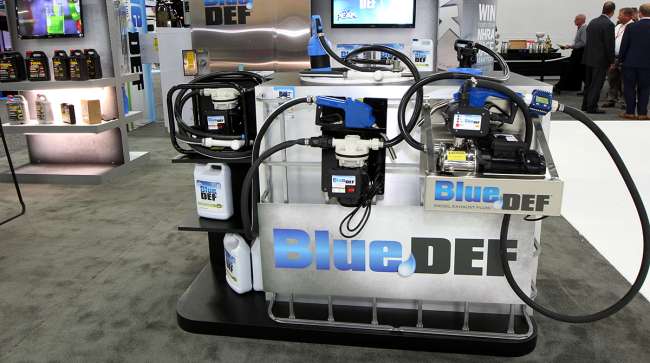Staff Reporter
Experts Warn of Spiking DEF Prices

[Stay on top of transportation news: Get TTNews in your inbox.]
Prices for the diesel exhaust fluid that is a vital component of emissions systems on newer trucks are rising as costs for urea — a core DEF ingredient — have jumped.
“We haven’t really seen a month-to-month change like this before,” Alex Wood, a senior analyst at Argus Media, told Transport Topics. “I think if you look at urea prices, in particular, this type of increase on a monthly basis probably hasn’t happened in five years. It’s certainly a noteworthy increase in price levels. But it’s all driven by urea prices.”
Wood noted that wholesale DEF prices paid at terminals increased about 10% between the first weeks of January and February. The Argus DEF Weekly report found that a major production site and terminal in Dallas-Fort Worth saw whole sale price paid free on-truck by customers go from a range of 61 to 64 cents per liquid gallon Jan. 8 to a range of 67 to 71 cents per liquid gallon Feb 5. That is the bulk price sold for a typical order size of around 1,500 gallons.
DEF is used in the exhaust stream of diesel-powered vehicles that use selective catalytic reduction emissions systems. The liquid helps break down nitrogen oxide emissions into nitrogen and water, which cleans up tailpipe emissions. DEF primarily is composed of the chemical urea and deionized water.
“The DEF prices directly track urea pricing in the U.S.,” Wood said. “We usually see prices rise in February, March and April every year. But I think particularly this year we see that happening a lot earlier than it usually does.”
International Raw Materials tracks urea prices weekly, and its data show a spike since Jan. 7. A recent report showed urea costs increased 25% month-over-month that month from $278 a ton to $357.71 a ton as of Feb. 11. In comparison, the cost of urea increased 6% from $261.80 a ton the prior month, closer to the overall trend since 2017. Currently, urea costs are at their highest since August 2014, when prices reached $358.33 a ton.
Several factors have contributed to the rise in urea costs. A 25% tariff imposed in 2019 by then-President Donald Trump on urea imported from China has contributed, but urea’s use in farming has also played a role.

Schaeffer
“Urea is one of the main components in fertilizer so as the farming industry starts to ramp up, then we’ll see the supply of urea tightening,” Allen Schaeffer, executive director at the Diesel Technology Forum, told TT. He noted that the coronavirus pandemic and bad weather contributed to a slower planting season in 2020, which softened agricultural demand for urea.
This year, that’s changing.
“I think things are back,” Schaeffer said. “Trucking is picking up as well, as the economy starts to climb its way out of the pandemic.”
Wood isn’t ready to say that costs are going to keep rising, noting that there have been signs in recent weeks that the jump in urea costs has started to slow down.
“We’ve seen the past two weeks a gradual softening of urea prices in the U.S.,” Wood said in mid-February. “We don’t really comment on where prices are supposed to go, but we’ve certainly seen, at least [in February], more volatile urea prices in the U.S.”
Want more news? Listen to today's daily briefing below or go here for more info:

